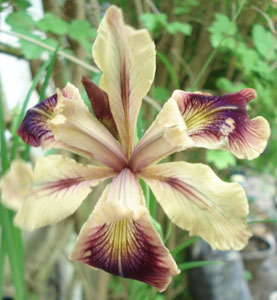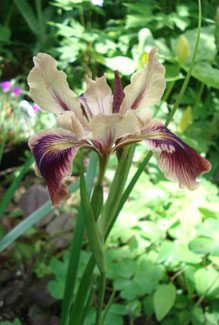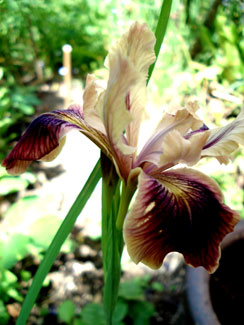
Iris 'For Ruth'
"Surely, you would be surprised if, having snipped off your little finger, & pushed it into a flower pot, you were to find a miniature edition of yourself in the flower pot a day later."
-Beverley Nichols
(1898-1983)
 I'm guessing the iris called 'For Ruth' is named for well known California coastal horticulturalist, iris breeder & centennarian Ruth Bancroft.
I'm guessing the iris called 'For Ruth' is named for well known California coastal horticulturalist, iris breeder & centennarian Ruth Bancroft.It's from the series "Californicae" which are commonly called "PCNs" or Pacific Coast Native irises.
'For Ruth' growers have not stated the hybrid history. Some breeders keep more than one hybridizable species in the same garden or greenhouse, so when something particularly nice develops from saved seeds, they've no idea what crossed with what to produce it.
There are eleven species categorized as "PCN." The great majority of the hybrids are derived from I. douglasiana x innominata, gaining moisture tolerance from the former, dryness tolerance from the latter, resulting in a strong garden plant. It appears that 'For Ruth' has gotten its purple hues from the former, its chocolate-magenta & yellow hues from the latter.
 I. innominata is native to the southern Siskiyou mountains of Oregon south into the Klamath mountains of northern California. I. douglasiana grows along the coast of southern Oregon & most of the coastal California but nowhere inland. Some hybrids of the eleven PCN species do exist in nature, but these two began their hybridizing life in gardens.
I. innominata is native to the southern Siskiyou mountains of Oregon south into the Klamath mountains of northern California. I. douglasiana grows along the coast of southern Oregon & most of the coastal California but nowhere inland. Some hybrids of the eleven PCN species do exist in nature, but these two began their hybridizing life in gardens.The multi-shaded flowers of purple & creamy white & yellow are particularly striking, a real stand-out for unique color. It's a dwarf iris flowering May & early June. It is usually under a foot tall for the slender grass, a little over a foot for the flower stem, with an arching habit for both grass & flower stems.
It seeds freely but if grown near other PCN species or hybrids, it is not apt to grow true from seed. The rhizomes spread slowly & can be divided every few years, or just permitted to grow wider in ground coverage. If the center ever stops blooming, only then it would be essential rather than optional to divide, but that could be never.
These are beardless irises, & though native to North America are most closely related to the Siberian Iris of Asia. Most are a lot shorter than the Siberian, & those which are evergreen don't have the ugly seasons' end burden of being a clump of straw. PCNs hybridise with Siberian irises quite freely, but some of them (the 'Calsibe' hybrids) are infertile.
Preferring moisture & plenty of sun, it actually adapts to a wide range of conditions, naturalizing easily. Summer days on Puget Sound are unusually long so a bit of afternoon or early evening shade is beneficial.
The leaves are quite tough & pliable. Sometimes when I need to tie something to a stake, I'll clip one blade from 'For Rruth' or from the nearby PCNs, Purdy's Iris or Toughleaf Iris, to use as a string. 'For Ruth' has evergreen leaves but the Purdy's leaves dry out at autumn's end, & are tough little strings even dried. I like this use of the blades because I don't have to go looking for twine, plus twine doesn't compost well after tied-back perennials have died back for winter, whereas the iris leaves used as twine will become leafmold by winter's end, beneficial to the garden.